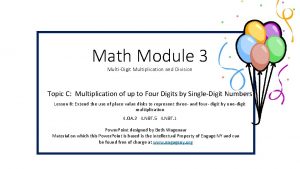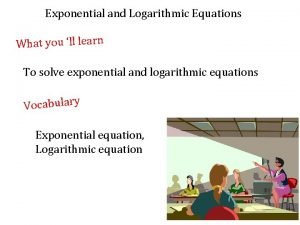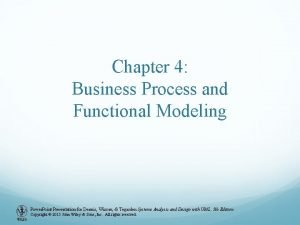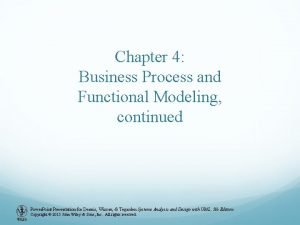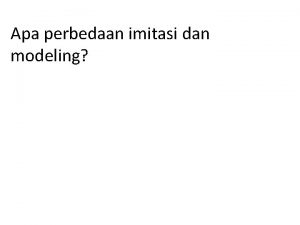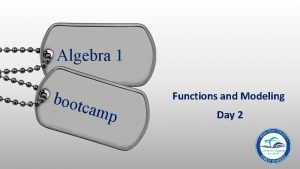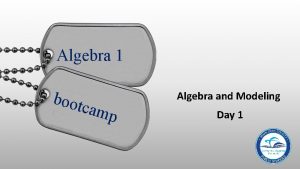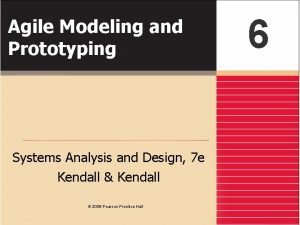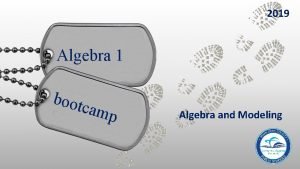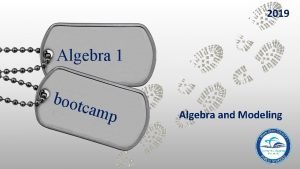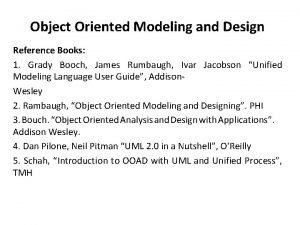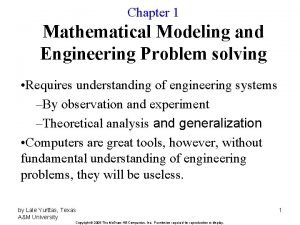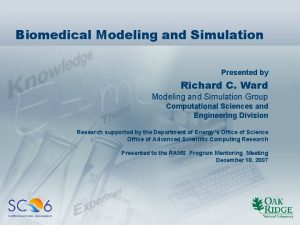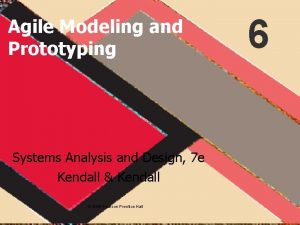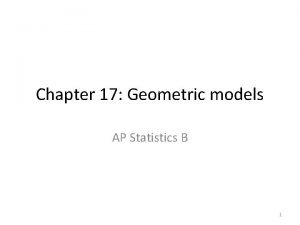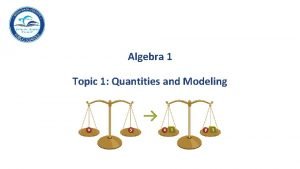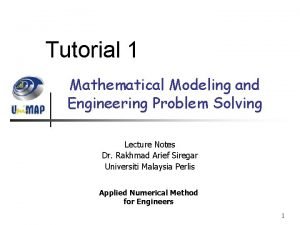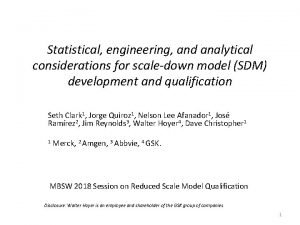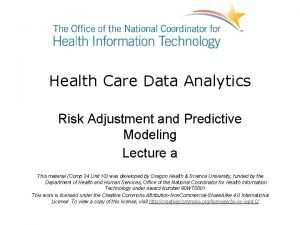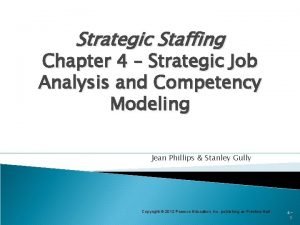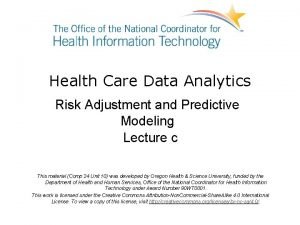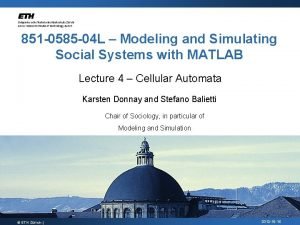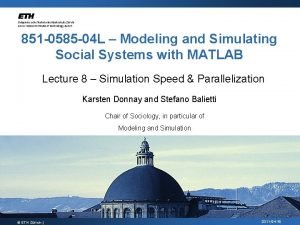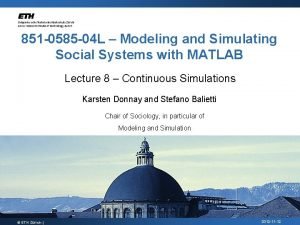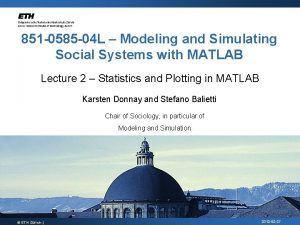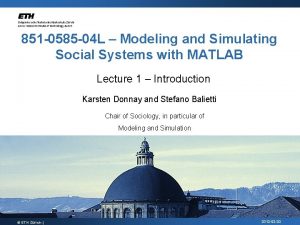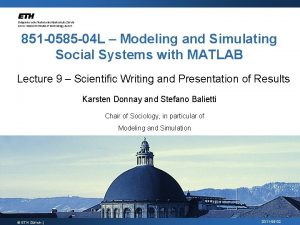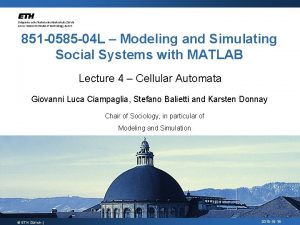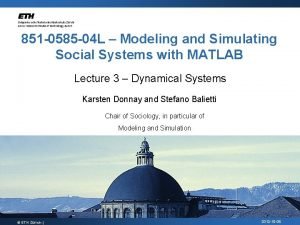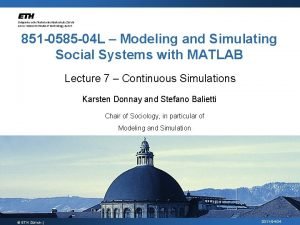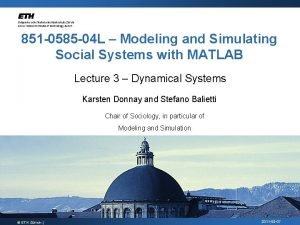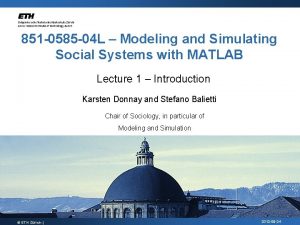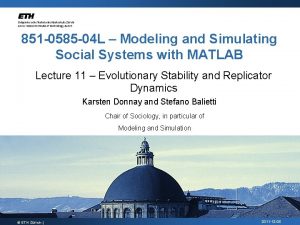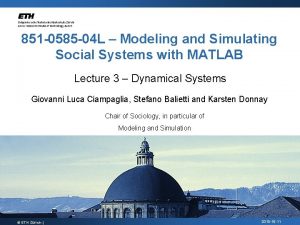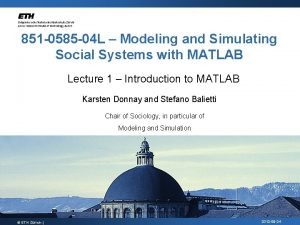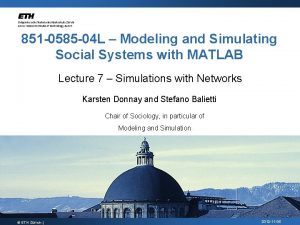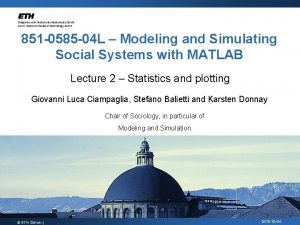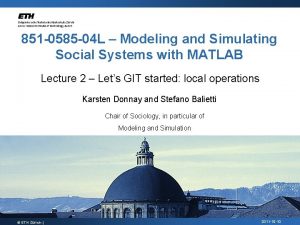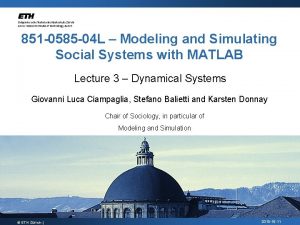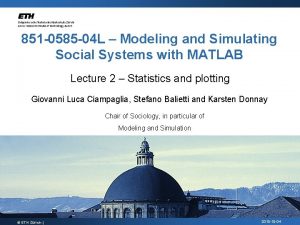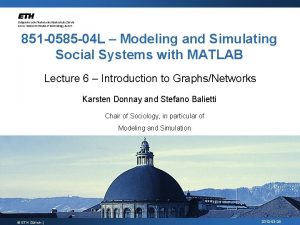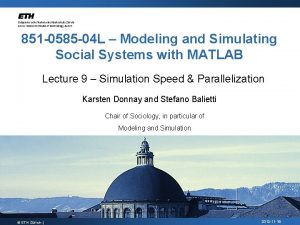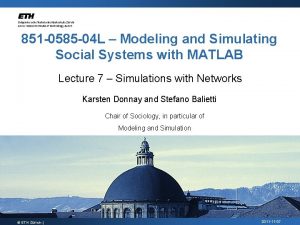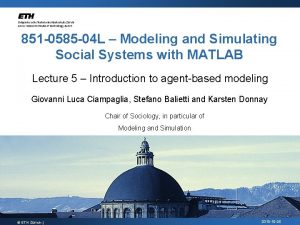851 0585 04 L Modeling and Simulating Social


![Repetition § Creating a row vector: >> v=[1 2 3 4 5] v = Repetition § Creating a row vector: >> v=[1 2 3 4 5] v =](https://slidetodoc.com/presentation_image/241f0c118cf7e430640c7adc4eb53612/image-3.jpg)


![Repetition § Creating a column vector: >> v=[1; 2; 3; 4; 5] v = Repetition § Creating a column vector: >> v=[1; 2; 3; 4; 5] v =](https://slidetodoc.com/presentation_image/241f0c118cf7e430640c7adc4eb53612/image-6.jpg)

![Repetition § Creating a matrix: >> A=[1 2 3 4; 5 6 7 8] Repetition § Creating a matrix: >> A=[1 2 3 4; 5 6 7 8]](https://slidetodoc.com/presentation_image/241f0c118cf7e430640c7adc4eb53612/image-8.jpg)
![Repetition § Creating a matrix, 2 nd method: >> A=[1: 4; 5: 8] A Repetition § Creating a matrix, 2 nd method: >> A=[1: 4; 5: 8] A](https://slidetodoc.com/presentation_image/241f0c118cf7e430640c7adc4eb53612/image-9.jpg)














![Lesson 1: Exercise 3 – iterative solution fibonacci. m: function [v] = Fibonacci(n) v(1) Lesson 1: Exercise 3 – iterative solution fibonacci. m: function [v] = Fibonacci(n) v(1)](https://slidetodoc.com/presentation_image/241f0c118cf7e430640c7adc4eb53612/image-24.jpg)































- Slides: 55

851 -0585 -04 L – Modeling and Simulating Social Systems with MATLAB Lecture 2 – Statistics and Plotting in MATLAB Karsten Donnay and Stefano Balietti Chair of Sociology, in particular of Modeling and Simulation © ETH Zürich | 2011 -10 -03

Goals of Lecture 2: students will 1. Consolidate knowledge of basic MATLAB functionalities acquired during lecture 1 through brief repetition of the main points and revision of the exercises. 2. Get familiar with some basic statistical functionality of MATLAB. 3. Understand the basic MATLAB 2 D plotting functionality and apply it appropriately; the example of logarithmic plots is discussed in detail. 4. Master positioning multiple graphs in the screen with subplot() and figure() and custom. m files. 2011 -10 -03 K. Donnay & S. Balietti / kdonnay@ethz. ch sbalietti@ethz. ch 2
![Repetition Creating a row vector v1 2 3 4 5 v Repetition § Creating a row vector: >> v=[1 2 3 4 5] v =](https://slidetodoc.com/presentation_image/241f0c118cf7e430640c7adc4eb53612/image-3.jpg)
Repetition § Creating a row vector: >> v=[1 2 3 4 5] v = 1 2 3 4 5 2011 -10 -03 K. Donnay & S. Balietti / kdonnay@ethz. ch sbalietti@ethz. ch 3

Repetition § Creating a row vector, 2 nd method: >> v=1: 5 v = 1 2 3 4 5 2011 -10 -03 K. Donnay & S. Balietti / kdonnay@ethz. ch sbalietti@ethz. ch 4

Repetition § Creating a row vector, 3 rd method: linspace(start. Val, end. Val, n) >> v=linspace(0. 5, 1. 5, 5) v = 0. 50 0. 75 1. 00 1. 25 1. 50 2011 -10 -03 K. Donnay & S. Balietti / kdonnay@ethz. ch sbalietti@ethz. ch 5
![Repetition Creating a column vector v1 2 3 4 5 v Repetition § Creating a column vector: >> v=[1; 2; 3; 4; 5] v =](https://slidetodoc.com/presentation_image/241f0c118cf7e430640c7adc4eb53612/image-6.jpg)
Repetition § Creating a column vector: >> v=[1; 2; 3; 4; 5] v = 1 2 3 4 5 2011 -10 -03 K. Donnay & S. Balietti / kdonnay@ethz. ch sbalietti@ethz. ch 6

Repetition § Creating a column vector, 2 nd method: >> v=[1 2 3 4 5]’ v = 1 2 3 4 5 2011 -10 -03 K. Donnay & S. Balietti / kdonnay@ethz. ch sbalietti@ethz. ch 7
![Repetition Creating a matrix A1 2 3 4 5 6 7 8 Repetition § Creating a matrix: >> A=[1 2 3 4; 5 6 7 8]](https://slidetodoc.com/presentation_image/241f0c118cf7e430640c7adc4eb53612/image-8.jpg)
Repetition § Creating a matrix: >> A=[1 2 3 4; 5 6 7 8] A = 1 2 3 4 5 6 7 8 2011 -10 -03 K. Donnay & S. Balietti / kdonnay@ethz. ch sbalietti@ethz. ch 8
![Repetition Creating a matrix 2 nd method A1 4 5 8 A Repetition § Creating a matrix, 2 nd method: >> A=[1: 4; 5: 8] A](https://slidetodoc.com/presentation_image/241f0c118cf7e430640c7adc4eb53612/image-9.jpg)
Repetition § Creating a matrix, 2 nd method: >> A=[1: 4; 5: 8] A = 1 2 3 4 5 6 7 8 2011 -10 -03 K. Donnay & S. Balietti / kdonnay@ethz. ch sbalietti@ethz. ch 9

Repetition § Accessing an element in a vector: >> v = 1: 10; >> v(2) ans = 2 2011 -10 -03 K. Donnay & S. Balietti / kdonnay@ethz. ch sbalietti@ethz. ch 10

Repetition § Accessing an element in a vector: >> v = 1: 10; >> v(2) ans = Vector indexes are 1 -based index = 1. . size ( v , 2 ) 2 1: column vector 2: row vector 2011 -10 -03 K. Donnay & S. Balietti / kdonnay@ethz. ch sbalietti@ethz. ch 11

Repetition § Accessing an element in a matrix: A(row. Index, column. Index) >> A(2, 1) ans = 5 2011 -10 -03 K. Donnay & S. Balietti / kdonnay@ethz. ch sbalietti@ethz. ch 12

Repetition - operators § Scalar operators: Basic: +, -, *, / Exponentialisation: ^ Square root: sqrt() 2011 -10 -03 K. Donnay & S. Balietti / kdonnay@ethz. ch sbalietti@ethz. ch 13

Repetition - operators § Matrix operators: Basic: +, -, * § Element-wise operators: Multiplication: . * Division: . / Exponentialisation: . ^ § Solving Ax=b: x = Ab 2011 -10 -03 Attention! / (slash) and (back slash) produce different results K. Donnay & S. Balietti / kdonnay@ethz. ch sbalietti@ethz. ch 14

Repetition – for loop § Computation can be automized with for loops: >> y=0; for x=1: 4 y = y + x^2 + x; end >> y y = 40 2011 -10 -03 K. Donnay & S. Balietti / kdonnay@ethz. ch sbalietti@ethz. ch 15

Repetition – if case § Conditional computation can be made with if: >> val=-4; if (val>0 ) abs. Val = val; else abs. Val = -val; end 2011 -10 -03 K. Donnay & S. Balietti / kdonnay@ethz. ch sbalietti@ethz. ch 16

Lesson 1: Exercise 1 § Compute: a) b) c) 2011 -10 -03 K. Donnay & S. Balietti / kdonnay@ethz. ch sbalietti@ethz. ch 17

Lesson 1: Exercise 1 – solution § Compute: a) >> (18+107)/(5*25) ans = 1 2011 -10 -03 K. Donnay & S. Balietti / kdonnay@ethz. ch sbalietti@ethz. ch 18

Lesson 1: Exercise 1 – solution § Compute: b) >> s=sum(1: 100) or >> s=sum(1: 1: 100) default value or >> s=sum(linspace(1, 100)) s = default value 5050 2011 -10 -03 K. Donnay & S. Balietti / kdonnay@ethz. ch sbalietti@ethz. ch 19

Lesson 1: Exercise 1 – solution § Compute: c) >> s=0; >> for i=5: 10 >> s=s+i^2 -i; >> end >> s s = 310 2011 -10 -03 K. Donnay & S. Balietti / kdonnay@ethz. ch sbalietti@ethz. ch 20

Lesson 1: Exercise 2 § Solve for x: 2011 -10 -03 K. Donnay & S. Balietti / kdonnay@ethz. ch sbalietti@ethz. ch 21

Lesson 1: Exercise 2 – solution >> A=[2 -3 -1 4; 2 3 -3 2; 2 -1 -1 -1; 2 -1 2 5]; >> b=[1; 2; 3; 4]; >> x=Ab x = 1. 9755 0. 3627 0. 8431 -0. 2549 Ax=b >> A*x ans = 1. 0000 2. 0000 3. 0000 4. 0000 2011 -10 -03 K. Donnay & S. Balietti / kdonnay@ethz. ch sbalietti@ethz. ch 22

Lesson 1: Exercise 3 § Fibonacci sequence: Write a function which computes the Fibonacci sequence until a given number n and return the result in a vector. § The Fibonacci sequence F(n) is given by : 2011 -10 -03 K. Donnay & S. Balietti / kdonnay@ethz. ch sbalietti@ethz. ch 23
![Lesson 1 Exercise 3 iterative solution fibonacci m function v Fibonaccin v1 Lesson 1: Exercise 3 – iterative solution fibonacci. m: function [v] = Fibonacci(n) v(1)](https://slidetodoc.com/presentation_image/241f0c118cf7e430640c7adc4eb53612/image-24.jpg)
Lesson 1: Exercise 3 – iterative solution fibonacci. m: function [v] = Fibonacci(n) v(1) = 0; if ( n>=1 ) v(2) = 1; end for i=3: n+1 v(i) = v(i-1) + v(i-2); end >> Fibonacci(7) ans = 0 1 1 2 3 5 8 13 2011 -10 -03 K. Donnay & S. Balietti / kdonnay@ethz. ch sbalietti@ethz. ch 24

Lesson 1: Exercise 3 – recursive solution fibo_rec. m: function f = fibo_rec(n) if n == 0 f(1) = 0; elseif n == 1 f(2) = 1; elseif n > 1 f = fibo_rec(n - 1); f(n + 1) = f(n) + f(n - 1); end >> fibo_rec(7) ans = 0 1 1 2 3 5 8 13 2011 -10 -03 K. Donnay & S. Balietti / kdonnay@ethz. ch sbalietti@ethz. ch 25

Statistics functions § Statistics in MATLAB can be performed with the following commands: Vector-based Mean value: mean(x) Median value: median(x) Min/max values: min(x), max(x) Standard deviation: std(x) Variance: var(x) Matrix-based Covariance: cov(x) Correlation coefficient: corrcoef(x) 2011 -10 -03 K. Donnay & S. Balietti / kdonnay@ethz. ch sbalietti@ethz. ch 26

Where can I get help? >>help functionname § >>doc functionname § >>helpwin § Click on “More Help” from contextual pane after opening first parenthesis, e. g. : plot(… § Click on the Fx symbol before command prompt. 2011 -10 -03 K. Donnay & S. Balietti / kdonnay@ethz. ch sbalietti@ethz. ch 27

2 D Plotting functions § 2 D plotting of curves (y vs x) in MATLAB Linear scale: plot(x, y) Double-logarithmic scale: loglog(x, y) Semi-logarithmic scale: semilogx(x, y) semilogy(x, y) Plot histogram of x: hist(x) 2011 -10 -03 K. Donnay & S. Balietti / kdonnay@ethz. ch sbalietti@ethz. ch 28

Logarithmic Scale § It uses the logarithm of a physical quantity instead of the quantity itself. § E. g. , increment on the axis are powers of 10 (1, 100, 1000, …) instead of 1, 2, 3, 4. § Examples: 2011 -10 -03 K. Donnay & S. Balietti / kdonnay@ethz. ch sbalietti@ethz. ch 29

Logarithmic Scale § It uses the logarithm of a physical quantity instead of the quantity itself. § E. g. , increment on the axis are powers of 10 (1, 100, 1000, …) instead of 1, 2, 3, 4. § Examples: Same distance between 1 -2 -3 and 10 -20 -30 2011 -10 -03 K. Donnay & S. Balietti / kdonnay@ethz. ch sbalietti@ethz. ch 30

Logarithmic Rescaling: example ? 2011 -10 -03 K. Donnay & S. Balietti / kdonnay@ethz. ch sbalietti@ethz. ch 31

Logarithmic Rescaling: example 2011 -10 -03 K. Donnay & S. Balietti / kdonnay@ethz. ch sbalietti@ethz. ch 32

Logarithmic Scale: examples § Decibel § Richter scale § Entropy in thermodynamics § Information in information theory. § PH for acidity and alkalinity; § Stellar magnitude scale for brightness of stars § bit [log 2] and the byte 8[log 2] 2011 -10 -03 K. Donnay & S. Balietti / kdonnay@ethz. ch sbalietti@ethz. ch 33

Logarithmic Scale: why and when to use it § If the data cover a large range of values the logarithm reduces this to a more manageable range. § Some of our senses operate in a logarithmic fashion (Weber–Fechner law) § Some types of equations get simplified: § Exponential: Y = ea. X -> semilog scale -> Y = -a. X § Power Law: Y = Xb -> log-log scale -> log. Y = b log. X 2011 -10 -03 K. Donnay & S. Balietti / kdonnay@ethz. ch sbalietti@ethz. ch 34

Logarithmic Scale 2011 -10 -03 K. Donnay & S. Balietti / kdonnay@ethz. ch sbalietti@ethz. ch 35

Back to plotting… details of plot § An additional parameter can be provided to plot() to define how the curve will look like: plot(x, y, ‘key’) Where key is a string which can contain: Color codes: ‘r’, ‘g’, ‘b’, ‘k’, ‘y’, … Line codes: ‘-’, ‘--’, ‘. -’ (solid, dashed, etc. ) Marker codes: ‘*’, ‘s’, ’x’ Examples: plot(x, y, ‘r--’) plot(x, y, ‘g*’) * * 2011 -10 -03 K. Donnay & S. Balietti / kdonnay@ethz. ch sbalietti@ethz. ch 36

Plotting tips § To make the plots look nicer, the following commands can be used: Set label on x axis: xlabel(‘text’) Set label on y axis: ylabel(‘text’) Set title: title(‘text’) 2011 -10 -03 K. Donnay & S. Balietti / kdonnay@ethz. ch sbalietti@ethz. ch 37

Plotting tips § Two additional useful commands: hold on|off § grid on|off § >> x=[-5: 0. 1: 5]; >> y 1=exp(-x. ^2); >> y 2=2*exp(-x. ^2); >> y 3=exp(-(x. ^2)/3); 2011 -10 -03 K. Donnay & S. Balietti / kdonnay@ethz. ch sbalietti@ethz. ch 38

Plotting tips >> plot(x, y 1); >> hold on >> plot(x, y 2, ’r’); >> plot(x, y 3, ’g’); 2011 -10 -03 K. Donnay & S. Balietti / kdonnay@ethz. ch sbalietti@ethz. ch 39

Plotting tips >> plot(x, y 1); >> hold on >> plot(x, y 2, ’r’); >> plot(x, y 3, ’g’); >> grid on 2011 -10 -03 K. Donnay & S. Balietti / kdonnay@ethz. ch sbalietti@ethz. ch 40

Subplot() and figure() § subplot(m, n, p) breaks the figure window into an m-by -n matrix and selects the pth axes object for the current plot. § The axes are counted along the top row of the figure window, then the second row, etc. § h = figure(. . . ) adds a new figure window to the screen. It also returns the handle to it, so it can be further processed. § E. g. : saveas(h, ’myimage. jpg’); 2011 -10 -03 K. Donnay & S. Balietti / kdonnay@ethz. ch sbalietti@ethz. ch 41

Subplot() by the way… We have already seen an example of a chart created using subplot on page 32. Could you reproduce it? 2011 -10 -03 K. Donnay & S. Balietti / kdonnay@ethz. ch sbalietti@ethz. ch 42

Exercises: working with datasets § Two datasets for statistical plotting can be found on the course web page (with NETHZ login) http: //www. soms. ethz. ch/matlab you will find the files: countries. m cities. m 2011 -10 -03 K. Donnay & S. Balietti / kdonnay@ethz. ch sbalietti@ethz. ch 43

Exercises: Datasets § Download the files countries. m and cities. m and save them in the working directory of MATLAB. 2011 -10 -03 K. Donnay & S. Balietti / kdonnay@ethz. ch sbalietti@ethz. ch 44

Exercises: Datasets – countries § This dataset countries. m contains a matrix A with the following specification: § Rows: Different countries § Column 1: Population § Column 2: Annual growth (%) § Column 3: Percentage of youth § Column 4: Life expectancy (years) § Column 5: Mortality 2011 -10 -03 K. Donnay & S. Balietti / kdonnay@ethz. ch sbalietti@ethz. ch 45

Exercises: Datasets – countries § Most often, we want to access complete columns in the matrix. This can be done by A(: , index) For example if you are interested in the lifeexpectancy column, it is recommended to do: >> life = x(: , 4); and then the vector life can be used to access the vector containing all life expectancies. 2011 -10 -03 K. Donnay & S. Balietti / kdonnay@ethz. ch sbalietti@ethz. ch 46

Exercises: Datasets – countries § The sort() function can be used to sort all items of a vector in inclining order. >> life = A(: , 4); >> plot(life) 2011 -10 -03 K. Donnay & S. Balietti / kdonnay@ethz. ch sbalietti@ethz. ch 47

Exercises: Datasets – countries § The sort() function can be used to sort all items of a vector in inclining order. >> life = A(: , 4); >> life. S = sort(life); >> plot(life. S) 2011 -10 -03 K. Donnay & S. Balietti / kdonnay@ethz. ch sbalietti@ethz. ch 48

Exercises: Datasets – countries § The histogram hist() is useful for getting the distribution of the values of a vector. >> life = A(: , 4); >> hist(life) 2011 -10 -03 K. Donnay & S. Balietti / kdonnay@ethz. ch sbalietti@ethz. ch 49

Exercises: Datasets – countries § Alternatively, a second parameter specifies the number of bars: >> life = A(: , 4); >> hist(life, 30) 2011 -10 -03 K. Donnay & S. Balietti / kdonnay@ethz. ch sbalietti@ethz. ch 50

Exercise 1 § Statistics: Generate a vector of N random numbers with randn(N, 1) Calculate the mean and standard deviation. Do the mean and standard deviation converge to certain values, for an increasing N? Optional: Display the histogram and compare the output of the following two commands § hist(randn(N, 1)) § hist(rand(N, 1)) 2011 -10 -03 K. Donnay & S. Balietti / kdonnay@ethz. ch sbalietti@ethz. ch 51

Exercise 2 § Demographics: From the countries. m dataset, find out why there is such a large difference between the mean and the median population of all countries. Hint: Use hist(x, n) Also sort() can be useful. § Plus: play with subplot() 2011 -10 -03 K. Donnay & S. Balietti / kdonnay@ethz. ch sbalietti@ethz. ch 52

Exercise 3 § Demographics: From the countries. m dataset, see which columns have strongest correlation. Can you explain why these columns have stronger correlations? Hint: Use corrcoef() to find the correlation between columns. Use imagesc()to get an immediate visualization of the correlations. 2011 -10 -03 K. Donnay & S. Balietti / kdonnay@ethz. ch sbalietti@ethz. ch 53

Exercise 4 – optional § Zipf’s law: Zipf’s law says that the rank, x, of cities (1: largest, 2: 2 nd largest, 3: 3 rd largest, . . . ) and the size, y, of cities (population) has a power-law relation: y ~ xb § Test if Zipf’s law holds for the three cases in the cities. m file. Try to estimate b. Hint: Use log() and plot() (or loglog()) § Plus: use the fitting tool cftool() to get b 2011 -10 -03 K. Donnay & S. Balietti / kdonnay@ethz. ch sbalietti@ethz. ch 54

References § Additional material on plotting on the home page of the course http: //www. soms. ethz. ch/matlab § "Log or Linear? Distinct Intuitions of the Number Scale in Western and Amazonian Indigene Cultures”, Science 320 (5880): 1217 § http: //en. wikipedia. org/wiki/Weber%E 2%80%93 F echner_law 2011 -10 -03 K. Donnay & S. Balietti / kdonnay@ethz. ch sbalietti@ethz. ch 55
 Post mortem changes
Post mortem changes Postmortem signs
Postmortem signs Modeling role modeling theory
Modeling role modeling theory 10 cfr 851
10 cfr 851 Ontario regulation 851
Ontario regulation 851 20 x 3
20 x 3 Relational vs dimensional data modeling
Relational vs dimensional data modeling 888-781-0585
888-781-0585 Ngic 888-781-0585
Ngic 888-781-0585 Social thinking adalah
Social thinking adalah Social thinking social influence social relations
Social thinking social influence social relations Four-model approach
Four-model approach Linear and quadratic functions and modeling
Linear and quadratic functions and modeling Describe data and process modeling concepts and tools
Describe data and process modeling concepts and tools Social darwinism vs social gospel
Social darwinism vs social gospel Simulation kelton
Simulation kelton Sequential decision analytics
Sequential decision analytics Log to exponential form
Log to exponential form Dfd chapter 5
Dfd chapter 5 System requirements checklist output example
System requirements checklist output example Business process and functional modeling
Business process and functional modeling Business process and functional modeling
Business process and functional modeling Modeling and imitation training aba
Modeling and imitation training aba Modeling and imitation
Modeling and imitation Algebra 1 bootcamp functions and modeling
Algebra 1 bootcamp functions and modeling Algebra 1 bootcamp algebra and modeling
Algebra 1 bootcamp algebra and modeling Algebra 1 bootcamp functions and modeling
Algebra 1 bootcamp functions and modeling Patched up prototype
Patched up prototype Additive and subtractive modeling
Additive and subtractive modeling Patched up prototype
Patched up prototype 2019 algebra 1 bootcamp answers
2019 algebra 1 bootcamp answers Algebra bootcamp answers
Algebra bootcamp answers Object oriented modeling and design books
Object oriented modeling and design books Pharmaceutical simulation and modeling
Pharmaceutical simulation and modeling Introduction to modeling and simulation
Introduction to modeling and simulation Data vault modeling pros and cons
Data vault modeling pros and cons Mathematical modeling and engineering problem solving
Mathematical modeling and engineering problem solving Biomedical modeling and simulation
Biomedical modeling and simulation Device modeling for analog and rf cmos circuit design
Device modeling for analog and rf cmos circuit design Patched up prototype
Patched up prototype Solid modeling and additive manufacturing
Solid modeling and additive manufacturing Pengertian pemodelan dan simulasi
Pengertian pemodelan dan simulasi Computational engineering and physical modeling
Computational engineering and physical modeling Geometric modeling in probability and statistics
Geometric modeling in probability and statistics Addition property of equality
Addition property of equality Job analysis vs competency modeling
Job analysis vs competency modeling Merger and acquisition financial modeling
Merger and acquisition financial modeling Softwares can_ -in designing and modeling in every field
Softwares can_ -in designing and modeling in every field Mathematical modeling and engineering problem solving
Mathematical modeling and engineering problem solving Site:slidetodoc.com
Site:slidetodoc.com Image-based modeling
Image-based modeling Open venation
Open venation Health care risk adjustment and predictive modeling
Health care risk adjustment and predictive modeling Manufacturing systems modeling and analysis
Manufacturing systems modeling and analysis Strategic job analysis and competency modeling
Strategic job analysis and competency modeling Predictive analytics risk adjustment healthcare
Predictive analytics risk adjustment healthcare





